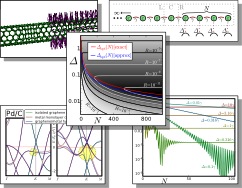Carrier injection into carbon nanotubes and graphene nanoribbons, contacted by a metal coating over an arbitrary length, is studied by various means: Minimal models allow for exact analytic solutions which can be transferred to the original system with high precision. Microscopic ab initiocalculations of the electronic structure at the carbon-metal interface allow us to extract -- for Ti and Pd as contacting materials -- realistic parameters, which are then used in large scale tight-binding models for transport calculations. The results are shown to be robust against non-epitaxially grown electrodes and disorder at the interface in general, as well as various refinements of the model.

Carrier injection into carbon nanotubes and graphene nanoribbons, contacted by a metal coating over an arbitrary length, is studied by various means: Minimal models allow for exact analytic solutions which can be transferred to the original system with high precision. Microscopic ab initiocalculations of the electronic structure at the carbon-metal interface allow us to extract -- for Ti and Pd as contacting materials -- realistic parameters, which are then used in large scale tight-binding models for transport calculations. The results are shown to be robust against non-epitaxially grown electrodes and disorder at the interface in general, as well as various refinements of the model.
